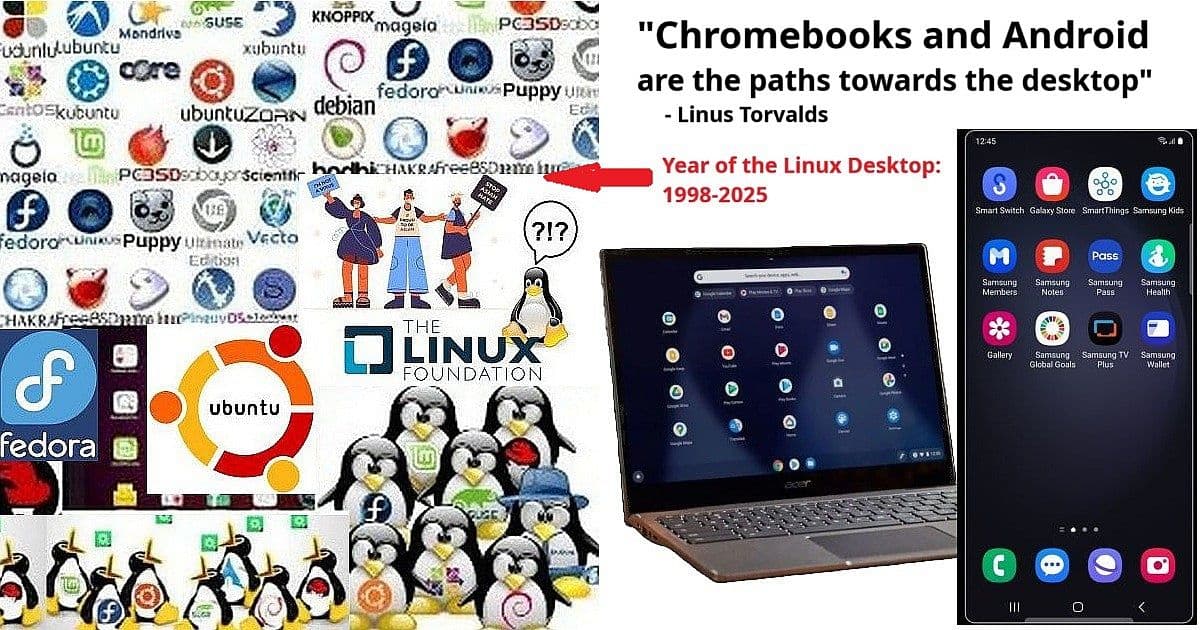
Since at least 1998, the Linux community has been declaring “this will be the Year of the Linux Desktop.” Twenty-seven years later, we’re still waiting. Meanwhile, something interesting happened that the Linux evangelists missed entirely: The Year of the Linux Desktop became the decade of Google everything.
While Linux enthusiasts argued about systemd vs. init and whether GNOME or KDE was superior, Google quietly conquered the world with actual desktop Linux adoption through Android and Chromebooks. They just didn’t ask users to compile kernels or edit config files to make it work.
Even Linus Torvalds, creator of Linux itself, agrees: “Chromebooks and Android are the paths towards the desktop.”
What Linus Torvalds Really Said About Desktop Linux
Even the creator of Linux doesn’t buy into the desktop hype. In his now-famous video “Linus Torvalds on why desktop Linux sucks,” Torvalds was brutally honest:
“One of the problems desktop Linux has is it’s not made for normal people, and by normal people I mean, obviously nontechnical people…”
This isn’t coming from some Windows fanboy or Apple zealot. This is from the man who created the kernel that powers everything from smartphones to supercomputers. When Linus Torvalds says desktop Linux has problems, maybe it’s time to listen.
But Torvalds didn’t stop there. In a comprehensive interview covered by It’s FOSS, he addressed the fragmentation issue directly, noting how “the fragmentation of the different vendors have, I think, held the desktop back a bit.”
The Linux Jihadists vs. The Technical Users
Here’s where things get interesting: the loudest voices promoting Linux desktop adoption are often the least qualified to make that argument.
The Linux Jihadists are typically:
- Nontechnical users who memorized some commands
- True believers who treat Linux as religion, not technology
- People who get personally offended by criticism of their chosen distro
- Evangelists who insist everyone should abandon Windows/Mac “for freedom”
The actual technical Linux users understand:
- Linux excels as a server OS and development platform
- Desktop Linux works great for specific use cases and technical users
- Forcing it on “normal people” is counterproductive
- Different tools for different jobs makes sense
The irony is thick: the people most qualified to advocate for Linux desktop adoption (actual developers and system administrators) are often the most realistic about its desktop limitations.
The Fragmentation Problem That Killed Desktop Dreams
Want to know why desktop Linux never achieved mainstream adoption? Try explaining the differences between these active distributions to your grandmother:
- Ubuntu vs. Kubuntu vs. Xubuntu vs. Lubuntu
- Fedora vs. CentOS vs. Red Hat
- Debian vs. Linux Mint vs. Elementary OS
- Arch vs. Manjaro vs. EndeavourOS
- openSUSE Leap vs. Tumbleweed
- [Insert 590+ other distros here]

This isn’t choice – it’s chaos. While Windows users get Windows and Mac users get macOS, Linux desktop presents newcomers with an overwhelming maze of options, each with passionate advocates insisting their choice is obviously superior.
The result: Analysis paralysis for newcomers and a fractured ecosystem that can never achieve the critical mass needed for mainstream software support.
How Google Actually Won the Linux Desktop War
While the Linux community spent decades arguing about desktop environments and package managers, Google took a different approach with Android and Chromebooks. Google created both the Android and ChromeOS operating systems while hardware partners like Samsung, Acer, and HP manufactured the actual devices – smartphones, tablets, and Chromebooks.
Android’s Success Formula:
- Linux kernel underneath (users don’t know or care)
- Consistent user interface across devices
- App store with familiar software
- “Just works” out of the box
- No terminal commands required ever
ChromeOS’s Education Dominance:
- Linux-based but users never see the terminal
- Simple, consistent interface
- Automatic updates that don’t break things
- Perfect for schools and basic computing needs
- Captured the “simple computer” market Linux desktop never could
The brilliant insight: Google succeeded with Linux desktop computing by hiding Linux. They gave users the stability and security of Linux without making them become Linux experts.
As Linus Torvalds himself acknowledged, “Chromebooks and Android are the paths towards the desktop.”
Linux Desktop’s Real Sweet Spot: Specialty Use Cases
This isn’t anti-Linux advocacy – it’s realistic Linux advocacy. Desktop Linux excels when used intelligently:
Perfect for Technical Users:
- Development environments
- Server administration workstations
- Security and penetration testing
- Scientific computing and research
Excellent as Specialty OS:
- Music production systems
- Retro gaming platforms
- Digital signage and kiosks
- Educational programming environments
- Privacy-focused computing
Brilliant for USB/Portable Systems:
- Live USB troubleshooting tools
- Portable work environments
- System recovery and diagnostics
- Testing hardware compatibility
Personal Example: I maintain 4-5 different Linux desktop distros on USB drives, with favorites being Fedora Cinnamon SPIN and Porteus Cinnamon. Porteus especially is an amazing small, powerful, and flexible OS perfect for specific tasks. This is intelligent Linux desktop usage – the right tool for specific jobs.
The Reality Check: Why This Matters
The continued insistence that “this year will be the Year of the Linux Desktop” actually hurts Linux adoption. It sets unrealistic expectations and wastes energy on the wrong battles.
Instead of fighting for desktop Linux dominance, the Linux community could:
- Celebrate Android’s massive success
- Improve Linux for its actual strengths (servers, development, embedded systems)
- Stop treating Linux desktop market share as a religious crusade
- Focus on making Linux desktop better for technical users who actually want it
The truth: Desktop Linux doesn’t need to “win” to be valuable. It’s already winning in servers, mobile devices, embedded systems, and specialized applications. That’s not failure – that’s finding the right market fit.
External Resources and Further Reading
For those interested in diving deeper into Linux desktop alternatives and development:
- Linux Foundation Training – Official Linux education resources
- DistroWatch – Comprehensive Linux distribution database
- Phoronix – Linux hardware and performance benchmarks
- OMG! Ubuntu! – Popular Ubuntu news and tutorials
- It’s FOSS – Linux news, tutorials, and reviews
Conclusion: Success Looks Different Than We Expected
Twenty-seven years of “Year of the Linux Desktop” predictions taught us something important: mainstream desktop Linux adoption was never the real goal. The goal was building better computing systems, and Linux has absolutely succeeded at that.
Google proved that Linux desktop computing can dominate consumer devices when implemented thoughtfully. Android didn’t succeed because it was “free as in freedom” – it succeeded because it worked reliably for normal people doing normal things.
Linus Torvalds was right when he said “Chromebooks and Android are the paths towards the desktop.” Maybe it’s time to retire the “Year of the Linux Desktop” meme and celebrate what Linux actually accomplished: powering the majority of the world’s smartphones, running most of the internet’s servers, and providing the foundation for countless innovations.
The Year of the Linux Desktop never came in the way we expected, but the decade of Linux everything already happened. We just weren’t looking in the right places.
Related Posts:
